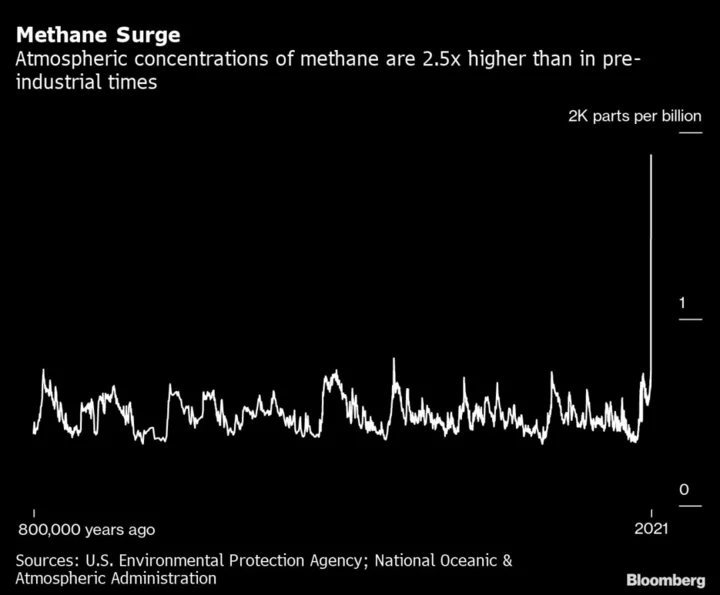(Bloomberg) --
It’s about to get very noisy in the climate world as more than 70,000 people flock to the United Arab Emirates for the COP28 summit starting next week. Making sense of the many announcements about to land will be a challenge.
The main headlines will rightly focus on what nearly 200 countries agree on at the United Nations-backed meeting. At the end of a year that’s set new records for the amount of planet-warming emissions released and global temperatures, the focus will be whether, despite growing geopolitical tensions, world leaders can do something meaningful to avert more catastrophic heating.
But the final communique isn’t the only place to search for progress. The vast majority of COP28 attendees aren’t government negotiators, they’re representatives of companies, non-profits and academic institutions who want to show their support for the cause in their own way. Some of that will come in the form of voluntary initiatives to tackle the myriad problems that a changing climate throws at us — from financing renewable energy projects to creating more benign food systems.
Those side deals are welcome, says Christiana Figueres, former chief of the UN’s climate body responsible for COP meetings. “But it’s not enough to gather the fruits and put them in a fruit salad,” she said. “We need more accountability.”
Comparing two pledges made at COP26 in Glasgow, one to halt deforestation and the other to address methane leaks, shows the limits and potential of these agreements.While more than 100 countries promised to stop and reverse deforestation in 2021, by last year two of the most-forested nations, Brazil and the Democratic Republic of Congo, had already begun backsliding. More trees were being cut down than before and the countries were embracing oil and gas more strongly. To try and remedy that, the UK proposed a new initiative at COP27 to “ensure a long-term delivery mechanism” for the Glasgow pledge that it oversaw. But this time, only 26 countries signed up.
(Brazil has started to turn the tide on deforestation this year with a new political administration in charge.)
It’s been a different story with the Global Methane Pledge, in which more than 80 countries agreed to collectively cut emissions of the super-potent greenhouse gas 30% by 2030. Since then, the number of signatories has nearly doubled, covering more than half the world’s methane emissions.
One reason for its success is that the oil and gas industry has gotten behind the mission to reduce methane. It’s a cheap and easy way for them to show that they’re taking action, and has the added benefit of lowering the carbon-intensity of their product as calls grow for a quicker move away from fossil fuels.
The methane announcement in 2021 provided a clear and achievable signal for companies, says Edmond Rhys-Jones, who co-leads Boston Consulting Group’s climate center. He says the firm was able to tell its clients, “we expect to see this cascading down into national policy, which is going to affect you directly.” BCG is now working with COP28’s leadership on a new initiative that will target planet-warming emissions from industrial sectors such as cement and steel.
Another reason the methane pledge has gained momentum is government support. The US and European Union have been major champions, with President Joe Biden earlier this year calling for major economies and philanthropies to commit $200 million to help developing countries meet the target.
And there has been progress outside the pledge. China is the world’s largest methane emitter, especially through coal mining, and isn’t a signatory to the Global Methane Pledge. But after diplomatic efforts from the US and the EU, it announced a plan to reduce methane emissions earlier this month. Something similar might happen with Turkmenistan, another major methane emitter that’s being courted by the US to step up emissions-reductions.
But there are limits to voluntarism. Some of the other large methane emitters, such as Russia and Iran, are unlikely to sign up to the Global Methane Pledge or be persuaded to take action in bilateral deals. That’s why, even as the side shows at COP meetings become bigger, there are growing calls for reforming the main process itself to set more aggressive targets to cut carbon emissions and raise money to help poor countries adapt to a warmer planet.
Figueres points out that COPs were designed to get world governments to sign off on legally binding climate goals, not to set specific policies on how to get there. Because each country’s circumstances are so different, COPs were “never meant to implement” detailed measures, she says. For example, each government that signed on to either the deforestation or methane pledge would have to make their own decisions on incentives and penalties to live up to the agreement.
But as the world continues to fall short of the high-level goal set in the Paris Agreement to limit global warming to 1.5C from pre-industrial times, a recurring debate in the world of climate diplomacy is whether there needs to be more emphasis on how to deploy solutions through policies and finance. “The question is,” Figueres said, “Does the COP get redesigned for this new purpose to support implementation?”
Akshat Rathi writes the Zero newsletter, which examines the world’s race to cut planet-warming emissions. His book Climate Capitalism is out now.

